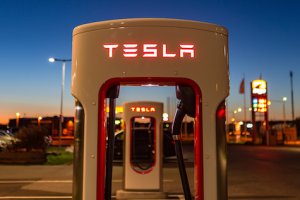Reindustrialization vs Financialization
GM’s $10-billion roadblock
The UAW strike against GM, which began on September 14, concluded six weeks later with UAW workers securing a long overdue boost to their wages and benefits that were cut prior to and during GM’s bankruptcy in 2009. Importantly, the UAW won the right to extend its master agreement to UAW members employed in GM’s EV battery production.
During the negotiations, GM’s CEO Mary Barra warned that the financial damage caused by the strike would threaten the company’s ability to invest in its EV transition, telling workers: “make no mistake: If we don’t continue to invest, we will lose ground, and it will happen fast … Nobody wins in a strike.”
In 2021, GM had announced an increase to $35 billion in projected costs for its EV transition from 2020 to 2025. Since 2018, when the company began to execute the transition, through Q3 2023, GM raked in $57.2 billion in net income, a large proportion of which comes from sales of its gas-guzzling, high-margin trucks, SUVs, and crossover vehicles. The profits from GM’s internal combustion engine (ICE) vehicles could be committed to funding the company’s EV transition. Instead, GM has been using its cash flow to give multibillion-dollar manipulative boosts to its stock price.
Notwithstanding Barra’s warning to GM’s workers about jeopardizing the EV transition, on November 29, the company announced that it was doing a $10-billion stock buyback in the form of an accelerated share repurchase (ASR). Given the market price of GM’s stock on November 29, the $10-billion ASR is equal to about 25% of the company’s shares outstanding.
An ASR differs from an ordinary stock buyback program by enabling the company to reduce shares outstanding by the full value of the authorized buybacks (in this case, $10 billion) on the date of the announcement. In contrast, an ordinary stock buyback program entails open market repurchases carried out periodically at management’s discretion over the life of the program. An ASR, therefore, gives an “accelerated” boost to earnings per share.
This ASR is in addition to the $4.9 billion in open-market repurchases that GM has carried out under ordinary buyback programs since 2022. Moreover, under GM’s existing repurchase authorization, Barra and her CFO Paul Jacobson can execute another $1.4 billion in open-market repurchases at their discretion. GM also announced a 33% increase in its dividends per share.
These massive distributions to shareholders raise questions about GM’s commitment to an EV transition. In January 2021, GM had stated its intention to produce only zero-emission battery EVs by 2035, echoing China’s announcement in late 2020 of a similar policy objective. In 2020, GM sold 2.9 million vehicles in China out of a worldwide total of 6.8 million.
In an interview on CNBC’s Squawk on the Street on the day of the $10-billion ASR announcement, Barra was asked about the prudence of this huge distribution to shareholders, given GM’s recent problems with its autonomous EV division Cruise as well as its declining market share in China, the nation that has surged to global leadership in the EV transition.
Barra was dismissive and vague, saying,
as we got through some of the elements of the year that were driving a lot of uncertainty, once we had that certainty, we were able to make this decision and get to a price or get to a place from a cash balance perspective that is more what we have said we want to have going forward, so this was really a reflection of our capital allocation framework. You know, when you look at the last few years, there’s been a lot of uncertainty, whether it’s the pandemic, semiconductor, labor, those are past us.
Over the past two decades, China has become a key market for GM. The company’s unit sales in China peaked at approximately 4 million vehicles in 2017 before declining 43% to 2.3 million in 2022. Of the GM cars sold in China in 2022, about 1.3 million were low-priced vehicles made by SAIC-GM-Wuling Automobile. GM’s sales of Chevrolets, Buicks, and Cadillacs in China dropped dramatically from about 1.9 million in 2017 to 1.0 million in 2022. The vast majority were ICE vehicles, which, given China and GM’s stated 2035 goal, will become increasingly irrelevant as the EV transition proceeds.
When questioned by CNBC about GM’s deteriorating market share in China, Barra recognized that Western companies like GM are being challenged by indigenous Chinese companies: “With this shift to electrification, there’s been a reset there. When you have a hundred new entrants coming into a market, there’s going to be a shift.”
Is GM committed to the EV transition?
CEO Barra acknowledges that GM’s EV transition has experienced “short-term bumps in the road”. By allocating GM’s cash to massive stock buybacks, however, GM’s investment in the EV transition is taking a backseat to distributions to the company’s shareholders. Meanwhile, formidable new competitors are making the transition happen.
In 2022, Tesla sold 1.3 million EVs worldwide, dominating the US and global markets for battery EVs. Tesla is on track to produce almost 2 million EVs by the end of 2023. China-based BYD sold 1.9 million battery and plug-in EVs worldwide and is likely to sell 3 million by the end of 2023. In 2022, over 10 million EVs were produced worldwide, with six of the world’s top 15 EV makers operating in China.
With the exception of Tesla, US companies competing in China do so through joint ventures with Chinese state-owned enterprises. Among US companies, GM’s joint venture with SAIC is the oldest and largest. GM counts as part of its sales in China, Baojun and Wuling units of its JV partners. Although their combined sales have fallen from 2.1 million in 2017 to 1.2 million in 2022, Wuling’s popular MiniEV series is a bestseller in China, with 400,000 EVs sold in 2022. In other words, for making the EV transition in China, GM is highly dependent on Wuling.
GM’s official target is to sell 2 million EVs annually by 2025—1 million in the US and 1 million in China. Not counting the EV sales of its JV partners, GM sold just 39,096 EVs in the US and approximately 20,000 in China in 2022. GM stated during its Q3 2023 earnings call that “execution” problems were slowing its EV production. The company as a result is pushing its production targets further out and falling further behind. In the first nine months of 2023, GM sold just 56,414 EVs in the US.
As it lost global market share, GM downsized its global labor force by 35%, from 225,000 in 2016 to 167,000 employees in 2022. Despite generating almost $20 billion from record profits in 2021 and 2022, in early 2023 GM set a cost-cutting target of $2 billion, half of which it sought to achieve by downsizing its US salaried employees by 5,000 (8% of the total) in April.
In 2021, GM had recalled 140,000 Bolt EVs to replace battery modules because of fire risks. The company planned to replace the Bolt with a new low-cost vehicle, using its Ultium battery platform (in partnership with LG Energy). To save $5 billion in its EV transition, however, GM has now reversed this decision, opting instead to resurrect its Bolt as its low-cost EV, sourcing lithium iron phosphate batteries from a Chinese producer. With its new Ultium battery plants facing long delays, GM’s newest EV trucks will not be widely available until at least 2025.
Finally, GM will save “hundreds of millions” of dollars by cutting investment in its Cruise division, after a deadly accident with one of its robotaxis resulted in a suspension of its license to operate in California. Far from being only “short-term bumps in the road”, GM’s parsimonious EV investment strategy could mark the beginning of a longer-term failure of its EV transition.
GM’s other investment strategy: manipulate the stock price
So why then, given the capital requirements of the EV transition, has GM executed $14.4 billion in buybacks as open market repurchases from 2015 through 2023, and allocated an additional $10 billion to buybacks in Q4 2023 in the form of an accelerated share repurchase? In interviews and in a press release, CEO Barra refers to GM’s buybacks as an opportunity, following the ratification of the UAW contract and plans to cut costs, for “returning excess capital to shareholders.”
“Returning” cash to shareholders? The problem is that GM’s current shareholders—or “owners” as Barra likes to call them—have not invested one cent in the productive capabilities that have enabled GM to generate products and profits. So how can cash be returned to them? Moreover, how can this cash be “excess” when during the same earnings guidance presentation as this term is used, GM lays out all the ways it is cutting costs, shortchanging its EV transition?
If not GM’s current shareholders, who then actually has invested in GM’s productive capabilities? Taxpayers and unions. As GM emerged from bankruptcy in June/July 2009 and re-listed on the stock exchange via an initial public offering in November 2010, Wall Street was nowhere to be found. In 2009, US taxpayers put up $49.5 billion in rescue funding, and Canadian taxpayers pitched in another $10.9 billion, enabling GM to emerge from bankruptcy after just 40 days. In 2010, the “New GM” did one of the largest initial public offerings in history, with share sales to the public of $23.1 billion by the US and Canadian governments as well as the UAW through its Voluntary Employee Beneficiary Association Trust.
None of the funds raised by listing GM’s common shares on the New York Stock Exchange went to GM for investment in productive capabilities or any other purpose. GM’s only funding from new shareholders was a preferred stock issue of $4.9 billion, of which $2.1 billion was used to repurchase part of a previous preferred stock issue to the US government and the remainder to help fund US hourly and salary pension plans. Once GM had gone public, all the new common shareholders did was buy outstanding shares on the liquid stock market.
The US government (and hence the US taxpayer) has also provided subsidies to GM’s EV transition. Under an Obama administration program launched in 2009, hundreds of thousands of GM car buyers received tax credits of up to $7,500 for purchasing the company’s plug-in hybrid and battery EVs. Under the Infrastructure Investment and Jobs Act and Inflation Reduction Act, the Biden administration is providing billions of dollars to expand the nation’s rapid EV charging networks and to subsidize EV production and purchase, subject to domestic content and income thresholds.
If the notion that GM has done over $24 billion in stock buybacks for the purpose of “returning excess capital” to its shareholders is fallacious, what purpose do these distributions really serve? They give manipulative boosts to GM’s stock price. One beneficiary of these stock price increases has been Mary Barra, who as CEO from 2014 to 2022 took home $248 million in total compensation, of which 55% were realized gains from the vesting of stock awards, and another 18% were realized gains from exercising stock options.
But what really motivates CEO Barra? Her father worked as a tool-and-die maker for GM for almost four decades, and she has been with the company for even longer, since attending GM Institute (now Kettering University) for her engineering degree. Under any circumstances, as CEO of a large US corporation, Barra would be paid exceptionally well. Given her background, it is likely that she would have preferred to see her gains from stock-based pay driven by EV innovation, not by stock-price speculation and manipulation.
Any senior executive seeking to invest in an innovative enterprise would not, on their own accord, do a $10-billion ASR. Not only was it massive, absorbing 25% of GM’s outstanding shares, but, in one fell swoop on November 29, 2023, the ASR took all 346 million shares off the market, increasing GM’s earnings per share by 25%. Under SEC Rule 10b-18, GM could do no more than $123 million in open market repurchases on any single trading day without foregoing the Rule’s safe-harbor protection against charges of stock-price manipulation.
Therefore, the $10-billion ASR was, as the name says, an accelerated manipulation of the market. With news of the ASR, GM’s stock price jumped 9% on November 29. As of December 15, GM’s stock price is up 24% to $35.73.
Why did GM’s board authorize the $10-billion ASR, knowing full well that it would seriously jeopardize GM’s EV transition? Barra and the board were worried about losing their positions of strategic control to hedge-fund activists who, using a corrupt proxy voting system (as Lazonick and Shin have shown), could have ousted them for failing to allocate corporate resources to stock-price manipulation.
GM’s buybacks reflect nearly constant pressure, sometimes publicly visible, sometimes not, to use buybacks to boost the company’s stock price. Besides padding the pay of senior executives, this stock-price manipulation can provide realized gains to stock traders who are in the business of timing the buying and selling of publicly listed shares. GM’s decisions to “return excess capital” reflect, in large part, a strategy to keep predatory shareholders, aka hedge-fund activists, at bay.
In January 2015, a corporate predator named Harry J. Wilson showed up at CEO Barra’s office, demanding that GM carry out $8 billion in stock buybacks and give him a seat on the board. Under the Obama administration’s automotive task force, Wilson had been the primary architect of the financing of the bailout. He was the one who insisted that the US government, on behalf of US taxpayers, fund the bailout by purchasing shares in the “new GM”. Deploying the “Government Motors” meme, Wall Street had pressured the US Treasury to sell its founders’ shares early, resulting in a $11.2 billion loss to US taxpayers.
With the government now having exited from its investment, Wilson could pretend that a group of hedge funds for which he was the frontman were the real “owners” of GM with a right to extract all its profits in the name of “maximizing shareholder value”. Barra and her board did not challenge Wilson’s premise but sought to appease the hedge funds with a $5-billion buyback program, while denying Wilson a seat on the board. Subsequently, GM did $6 billion in buybacks in 2015 and 2016.
Then, in 2017, hedge-fund activist David Einhorn publicly demanded three seats on GM’s board and wanted to split the company in two. Einhorn was willing to cease and desist after GM agreed to spend $5 billion on buybacks—in part funded by GM’s divestment from its European businesses, reducing GM’s worldwide employment by 45,000.
In an October 2018 Reuters article, hedge-fund manager John Levin described GM as a “tempting morsel to somebody,” and warned that the company faced its third activist campaign in four years if no action was taken to boost the company’s stock price. But no new public activist campaign surfaced.
Next came the Covid-19 pandemic, during which GM’s stock price declined to a low of about $18/share in Q1 2020, and then exploded to about $64/share in 2021. Throughout 2022, however, despite record profits from the sale of high-margin ICE trucks and SUVs, GM’s stock price slid, possibly because shareholders were skeptical of the investments that GM was making in its EV transition. By Q2 2022, GM’s stock price had fallen to $32/share, half its 2021 peak.
One high-profile shareholder who was dumping GM shares in 2022 and 2023 was Warren Buffett (on behalf of Berkshire Hathaway). At the beginning of 2022, Buffett held 62 million shares worth approximately $2.7 billion. By the beginning of the third quarter of 2023, Buffett had 22 million shares remaining, which he then sold off for $848 million.
During 2023, GM’s stock price continued to fall despite high profits. On November 28, GM’s stock price of $28.81 was down from its 2023 peak of $42.64 on February 16. Institutional shareholders continued to sell off their holdings.
A considerable amount of those sales must have been absorbed by the four banks—Bank of America, Goldman Sachs, Barclays, and Citibank—involved in GM’s $10-billion ASR. In the announcement of the ASR on November 29, GM disclosed that $6.8 billion of the repurchased shares were being received and retired immediately, which means that the banks would have had to have purchased about 235 million GM shares prior to the announcement date. In addition, the banks would have had to borrow from institutional shareholders about 111 million shares to be subsequently repurchased (in accordance with the safe-harbor conditions of SEC Rule 10b-18) on the open market over the course of the ASR through the end of 2024.
Why did CEO Barra and the board engage in this massive stock-price manipulation at the expense of investment in the company’s EV transition? Like all major US corporations in the era of “maximizing shareholder value”, GM’s senior executives are far more aligned with the company’s shareholders than they are with the company’s employees or customers. In the end, it is hedge-fund activists, typically holding a very small fraction of the company’s shares, who, despite making absolutely no productive or financial contribution to the company, call the resource-allocation shots. In doing $24.4 billion in stock buybacks since 2015, Barra and her board have been intent on appeasing the hedge-fund activists for the sake of keeping their jobs.
They have so far succeeded but, as a result, GM’s EV transition is now looking bleak. The company could be using more of its ICE profits to fund the EV transition. Instead, it is wasting them on an attempt to boost its sagging stock price. There is growing evidence that corporate financialization, manifested by stock buybacks, is causing the United States to lose out on a range of critical technologies. The icing of GM’s EV transition is a telling case in point.







